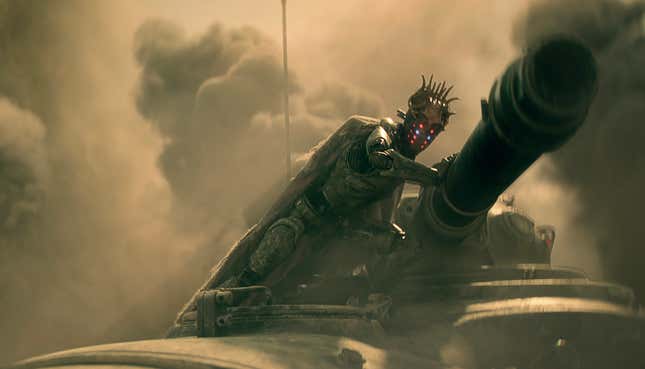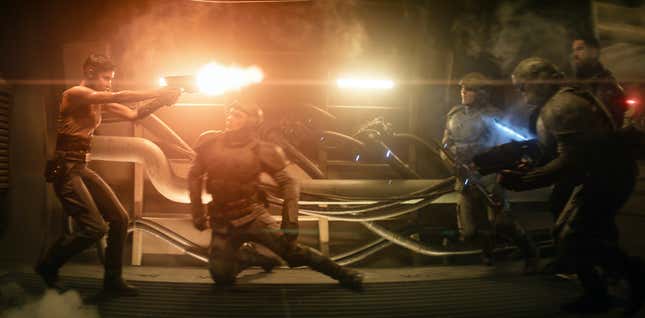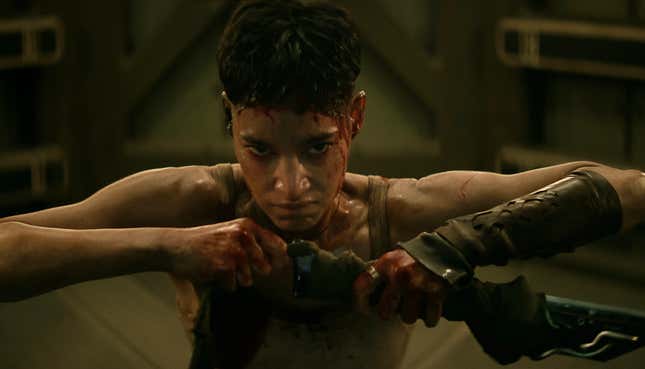The second half of Zack Snyder’s Rebel Moon is out this week and, believe it or not, it’s like a completely different movie. While Part One: A Child of Fire, followed the heroic Kora (Sofia Boutella) across the galaxy as she picked up allies, Part Two: The Scargiver is way more focused. Everything takes place on one planet, aiming at one event, and even though it’s a big, vibrant Zack Snyder movie, it feels somehow restrained.
Which, according to Snyder, was not necessarily the plan. io9 spoke to the writer, director, and producer behind Rebel Moon – Part Two: The Scargiver on video chat recently and asked him about making the parts of the film so different. We also discussed how he settled on which characters to focus on in which film, how he decides what makes the first cut as opposed to an extended cut, and just his general process for creating this world. Read about that, and much more, in our interview below.
Rebel Moon – Part Two: The Scargiver is on Netflix April 19.
This interview has been edited for length and clarity.
Germain Lussier, io9: I was surprised to see that Part Two feels like a completely different movie from the first part. Was that a specific, deliberate choice on your behalf? Tell me a bit about differentiating between the two.
Zack Snyder: Okay, so first of all, I wrote it as a single story. So if you can think about it in those terms, the threat comes to the village, Kora goes out into the galaxy and collects the heroes, comes back to the village, brings in the harvest, and then we prepare for the coming war. So you can imagine the DNA was kind of set in stone in some way that it was going to be a Veldt-centric, harvest-centric, kind of culture-centric movie with redemption stories of our heroes mixed in. And then a big war movie for the last 15 minutes. And so shooting them and putting them together was a single process because we shot them all together. So weirdly, the schedule did work out so we were shooting mostly the second movie at the end of the schedule because we planted all that wheat. We had to wait for it to mature. We were harvesting the wheat while preparing for the battle, so it all worked out in a weird production model that mimicked the movie in some weird way—it was kind of serendipitous and fun at the same time.

io9: Oh, that’s cool. Another cool thing I liked coming out of the first movie is Jimmy. I was intrigued by that character, which I think was the point, and we get to see more of him here. How do you figure out how to deploy a character like that? Because certainly there’s still mystery surrounding him even after this film. So how much do you know, and tell me a bit about how you decided to use him?
Snyder: It was a bit of a process of elimination. When you see the director’s cuts in August—I think it’s August—but when you see the director’s cut, you’re going to see many more Jimmy scenes. There are probably [looks up thinking] one, two, three, four, five, additional Jimmy scenes where he’s out in the wilderness, sort of waxing poetic about his place in the universe, [with Anthony] Hopkins sonnets about what it is to be Jimmy. So that stuff is much more.
And then in the second movie, there’s another little B story in the director’s cut that you don’t see. The big scene, of course, is where Kora and Jimmy meet up behind the waterfall and they have their philosophical discussion about what it is to be a warrior and serve a king. And I think that was really to establish him as a bit of a doubter so that he himself could realize what his role would be as [spoiler]. So, yeah, it’s a difficult thing to kind of parcel that out.
But there were other factors affecting how much Jimmy we wanted. And that’s in regard to length and things like that. But I think in the end, it’s an honor to have Hopkins voicing this incredible character. And, like I said, if you’re a Jimmy fan, you’re not going to be light on Jimmy come August. You [will] get a full banquet of Jimmy.

io9: The Jimmy banquet coming soon. Got it. Jumping off that, when you’re shooting, do you get a sense with a character that you may have five or six extra scenes left over like that? Obviously, you knew going into this that you had a lot more space with Netflix to release multiple versions, so do you have an idea when you’re shooting of what’s going where and in what version?
Snyder: Yeah. I mean, the script that I wrote, which was the hard, R-rated, super long version? I shot that. And so, process of elimination? Yeah, there are things that when you’re shooting it, you’re like, “I don’t know if this is going to make the PG-13.” I mean, there are some things obviously that aren’t. You know, like naked people. But I think with Jimmy it was really a matter of, we knew the shots were amazing and these sequences were super cool that we’re shooting with him, but it was just, if we’re trying to get a two-hour movie made, this is not it.
io9: Got it. Now, I won’t spoil it, but characters die in this movie. There are some stakes along the way. Do you know who’s going to die at the beginning of the writing, or does that kind of come out of the process of figuring everything out?
Snyder: Yeah, when I’m sort of whiteboarding the movie and I’ve got all the big concepts up, I pretty much kill the people that I’m going to kill then.
io9: So that early on.
Snyder: Yeah, it’s pretty realized. All the scenes are laid out and maybe I’ve written a couple scenes, but, I like to write the openings of the movies and sort of the ends first, and then I go and fill it in. And at that point, pretty much, the dead ones are dead.

io9: Gotcha. Now in that process, as well as the writing, you are creating this whole world. So you have to consider that as well as tell a cohesive story. One that ends, but still has threads to explore moving ahead. So I’m curious, you have this huge script, you shoot so much of it, you have to cut it down, how do you know what makes a director’s cut, what makes a potential sequel, how do you keep that all straight?
Snyder: Yeah, I have three lines running. There’s the big line, which is like the mythological storyline, which would include Kora’s eventual return to the Motherworld to fight Balisarius.
io9: Right.
Snyder: Then I have the line that is our story, where it leaves off, and what is practical and satisfying. And then underneath it, I have all the smaller stories within our stories, and how much we should tell. Like how much Jimmy do I need? In the backstory of Millius, how much do I learn about her agricultural village upbringing that was destroyed by the Motherworld? Maybe a little more in the director’s cut? And how much in this is really [important]?
You know, the great thing for me was that I knew I had it. I have these longer versions that are rated R and super violent or whatever. So if a scene, say, was too violent or too sexually charged, it might easily drop off to the director’s cut that way, you know? So there were like weird, cool rules that I could apply to it, that I could kind of start to narrow down.
Rebel Moon – Part Two: The Scargiver is on Netflix April 19.
Want more io9 news? Check out when to expect the latest Marvel, Star Wars, and Star Trek releases, what’s next for the DC Universe on film and TV, and everything you need to know about the future of Doctor Who.
Trending Products

Cooler Master MasterBox Q300L Micro-ATX Tower with Magnetic Design Dust Filter, Transparent Acrylic Side Panel…

ASUS TUF Gaming GT301 ZAKU II Edition ATX mid-Tower Compact case with Tempered Glass Side Panel, Honeycomb Front Panel…

ASUS TUF Gaming GT501 Mid-Tower Computer Case for up to EATX Motherboards with USB 3.0 Front Panel Cases GT501/GRY/WITH…

be quiet! Pure Base 500DX Black, Mid Tower ATX case, ARGB, 3 pre-installed Pure Wings 2, BGW37, tempered glass window

ASUS ROG Strix Helios GX601 White Edition RGB Mid-Tower Computer Case for ATX/EATX Motherboards with tempered glass…










